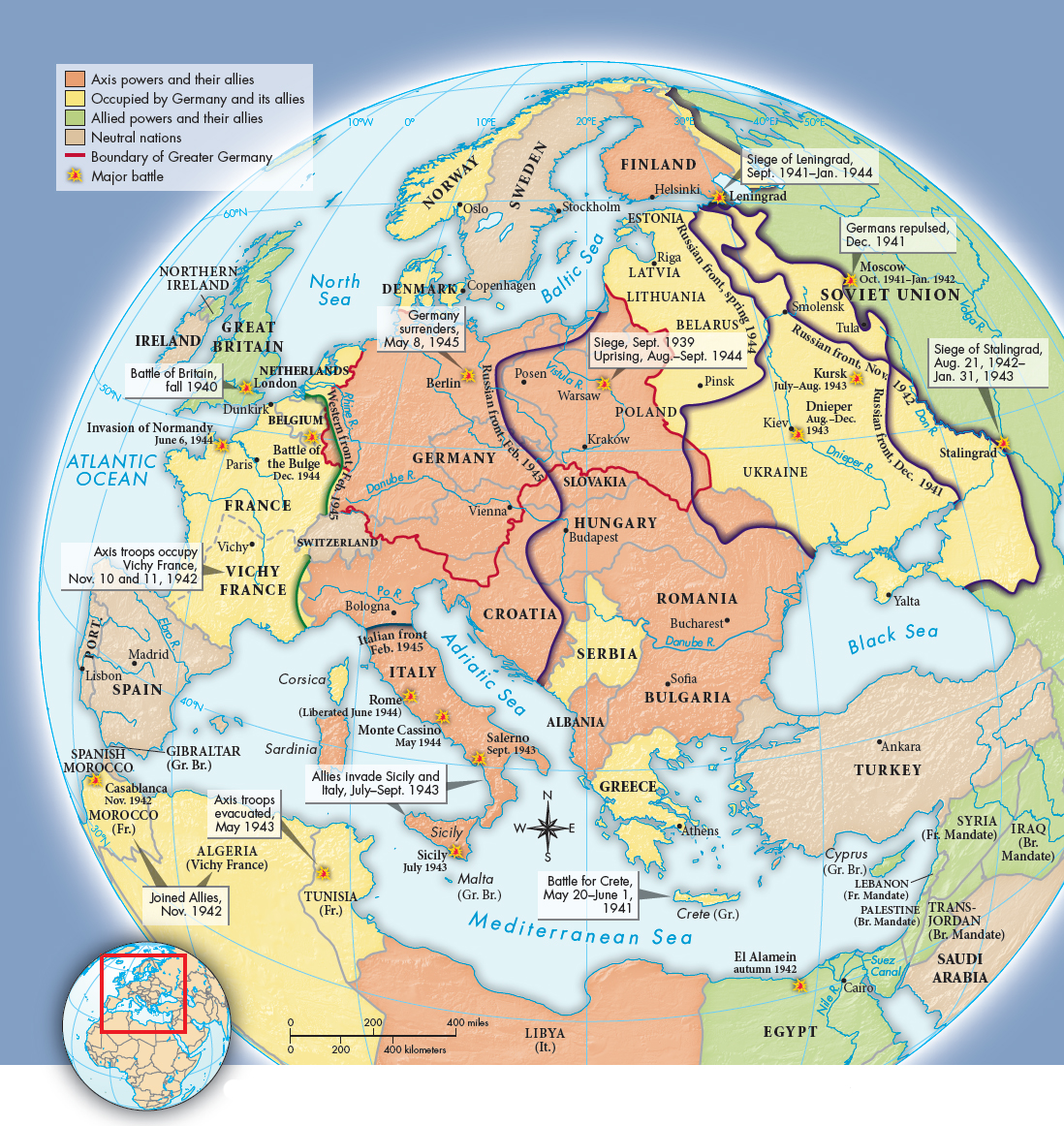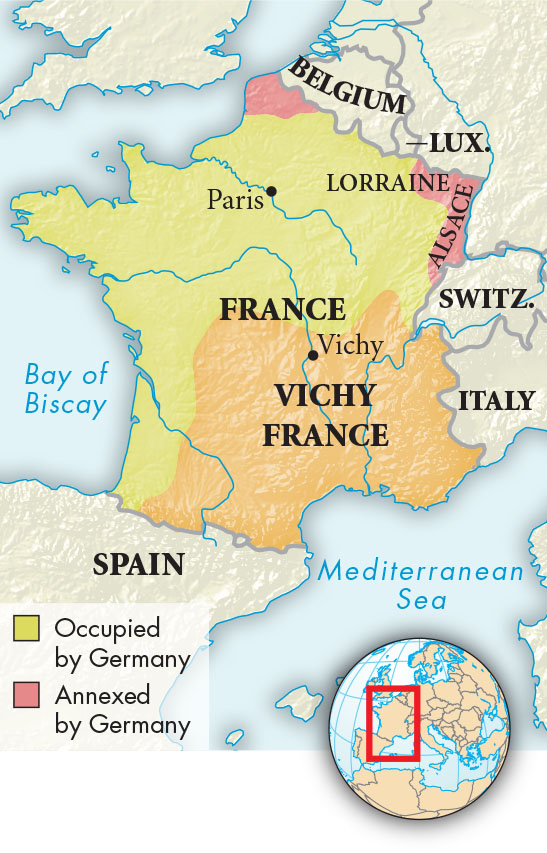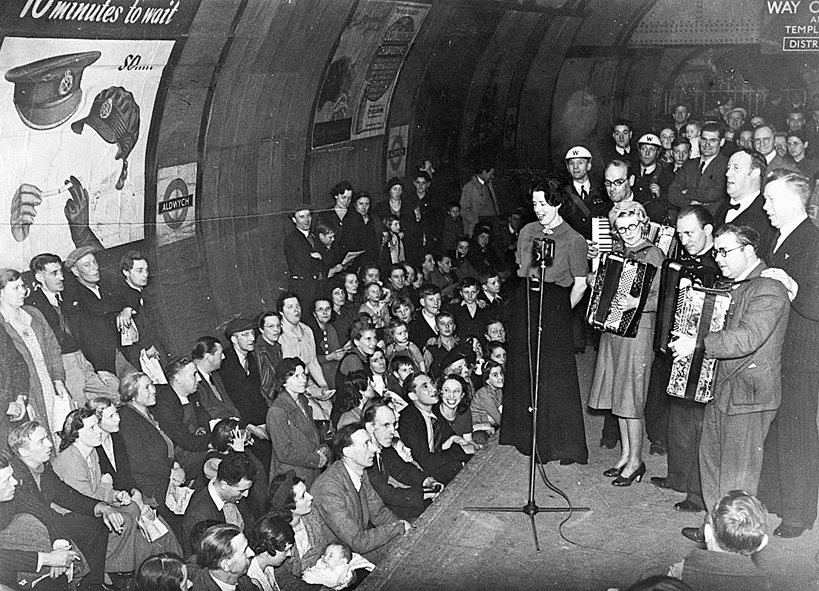A History of World Societies:
Printed Page 939
A History of World Societies Value
Edition: Printed Page 950
Hitler’s Empire in Europe, 1939–1942
Using planes, tanks, and trucks in the first example of a blitzkrieg, or “lightning war,” Hitler’s armies crushed Poland in four weeks. The Soviet Union quickly took its share agreed to in the secret protocol — the eastern half of Poland and the Baltic states of Lithuania, Estonia, and Latvia. In the west French and British armies dug in; they expected another war of attrition and economic blockade. But in spring 1940 the Nazi lightning war struck again. After occupying Denmark, Norway, and Holland, German motorized columns broke through southern Belgium and into France.
As Hitler’s armies poured into France, aging marshal Henri-


To prepare for an invasion of Britain, Germany first needed to gain control of the air. In the Battle of Britain, which began in July 1940, German planes attacked British airfields and key factories, dueling with British defenders high in the skies. In September Hitler began indiscriminately bombing British cities to break British morale. British aircraft factories increased production, and Londoners defiantly dug in. By September Britain was winning the air war, and Hitler abandoned his plans for an immediate German invasion of Britain.
Hitler now allowed his lifetime obsession of creating a vast eastern European empire for the “master race” to dictate policy. In June 1941 Germany broke the Nazi-
Although stalled in Russia, Hitler ruled an enormous European empire stretching from the outskirts of Moscow to the English Channel. He now began building a New Order based on the guiding principle of Nazi totalitarianism: racial imperialism. Within the New Order, the Dutch, Norwegians, Swedes, and Danes received preferential treatment, for the Germans believed they were racially related to the German “Aryan” master race. The French, an “inferior” Latin people, occupied the middle position. At the bottom of the New Order were the harshly treated “subhumans,” Jews and Slavs.

Hitler envisioned a vast eastern colonial empire where enslaved Poles, Ukrainians, and Russians would die or be killed off while Germanic peasants would resettle the abandoned lands. Himmler and the elite SS corps, supported by military commanders and German policemen, implemented a program of destruction in the occupied territories to create room for Germans. Many Poles, captured Communists, Gypsies, and Jehovah’s Witnesses were murdered in cold blood.
| 1919 | Treaty of Versailles is signed |
| 1921 | Hitler heads National Socialist German Worker’s Party (Nazis) |
| 1922 | Mussolini seizes power in Italy |
| 1927 | Stalin takes control of the Soviet Union |
| 1929– |
Great Depression |
| 1931 | Japan invades Manchuria |
| January 1933 | Hitler is appointed chancellor of Germany |
| March 1933 | Reichstag passes the Enabling Act, granting Hitler absolute dictatorial power |
| October 1933 | Germany withdraws from the League of Nations |
| 1935 | Nuremberg Laws deprive Jews of all rights of citizenship |
| March 1935 | Hitler announces German rearmament |
| October 1935 | Mussolini invades Ethiopia and receives Hitler’s support |
| March 1936 | German armies move unopposed into the demilitarized Rhineland |
| October 1936 | Rome- |
| 1936– |
Spanish Civil War |
| 1937 | Japan invades China |
| March 1938 | Germany annexes Austria |
| September 1938 | Munich Conference: Britain and France agree to German seizure of the Sudetenland from Czechoslovakia |
| March 1939 | Germany occupies the rest of Czechoslovakia; appeasement ends in Britain |
| August 1939 | Nazi- |
| September 1, 1939 | Germany invades Poland |
| September 3, 1939 | Britain and France declare war on Germany |